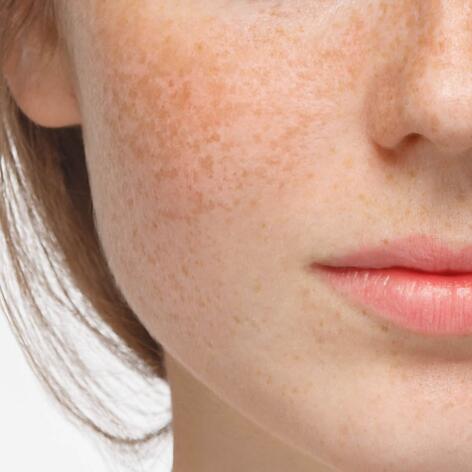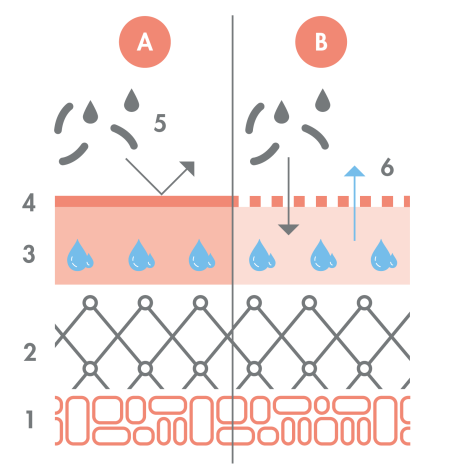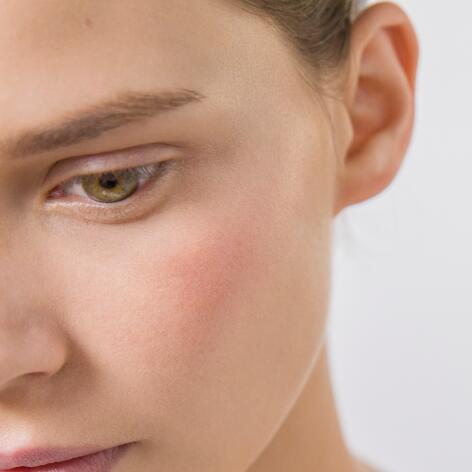Hypersensitive and intolerant skin
Hypersensitive or intolerant skin is not always sufficiently armed against the aggressions of everyday life. Get to know your skin better and choose the right products to care for it.

Intolerant skin: what is it really?
Hypersensitive and intolerant skin is skin that reacts quickly to aggression, which is why it is also called hypersensitive and reactive skin.
To find out if you are really affected, there are certain signs that can be detected. If you feel a flush as soon as you apply a new moisturiser, if you blush easily up to your ears or if a gust of wind causes an unpleasant tingling sensation, your skin is probably hypersensitive and reactive. If this discomfort and redness multiplies, the diagnosis becomes clear!
How can you tell the difference between intolerant and allergy-prone skin?
Intolerant and reactive skin is fragile by nature. This is due to the fact that the skin barrier is not as protective as it should be and the sensory sensors on its surface are more easily triggered. This type of skin is therefore less well equipped to resist the aggressions of everyday life. This is why you feel that anything can make it react, in an unpredictable way.
Allergy-prone skin is skin that reacts abnormally to an allergenic substance. The allergic reaction is more or less visible on the skin: eczema, hives, itching or simple red patches. The most common allergic reaction is a contact allergy: the skin reacts to simple contact with a product or material (ranging from perfume to metals) which triggers a reaction in the epidermis. But not all allergic reactions are contact-related: they can also be respiratory-, food- or drug-related.
A: Healthy skin barrier - B: Impaired skin barrier

I’m always afraid that my skin will react to external elements or to emotions. I never know when it will start or go away.
MELANIE, 33 years old
What makes hypersensitive skin react?
Why is the skin on your face so irritable? Why does your skin itch or your face turn red? To better prevent your hypersensitive skin from reacting, learn to recognise what can cause these discomforts.

Can skin hypersensitivity be reduced? With the right care, yes!
A few rays of sun on your skin or a stressful period, and a real feeling of discomfort appears. When you get ready in the morning, you run the risk of getting redness when you try a new moisturiser. This daily discomfort can affect anyone with hypersensitive skin. To take care of hyper-reactive skin types, such as those with intolerant skin, it’s essential to use a cosmetic product that doesn’t contain irritating substances. This helps to relieve irritation and limit the hypersensitivity of the skin. Intolerant skin is often thin, fair and dry, and needs skin care products that contain only substances that meet its requirements in order to prevent further aggravation.
How to care for intolerant skin
When you wake up in the morning, at work or on the road, but also in the evening before going to bed: your hypersensitive skin sometimes gives you no relief. Fortunately, there are a number of ways to prevent irritation and relieve tingling, tightness and redness. By implementing a simple and effective daily skin care routine and choosing the right skin care products, your hyper-reactive skin will be soothed.


How to react quickly in the event of a crisis
All it takes is the application of an unsuitable beauty product or sometimes just a cold breeze for the skin to react. Hypersensitive and intolerant skin heats up, the face starts to tingle or redness appears. At such times, you need to know how to react to prevent the discomfort from setting in. Here are a few simple (but effective) gestures that can quickly soothe your skin.
FRIENDLY (AND EXPERT) ADVICE
Moisturising is key!
The skin barrier plays two important roles: it protects against external aggressors and it retains the water contained in your skin. If you have intolerant skin, its fragile barrier is naturally more permeable to aggressors but also lets water escape from your skin. Your hyper-reactive skin is therefore all the more sensitive because it is often dry and dehydrated. One of the keys to caring for hypersensitive skin is to use soothing moisturisers to strengthen the skin's barrier and make it stronger against the elements.
OUR SOLUTIONS FOR HYPERSENSITIVE AND INTOLERANT SKIN
Eau Thermale Avène skin care products designed to make you feel better in your uncomfortable skin

TOLERANCE CONTROL SOOTHING CREAM
Recommended by my pharmacist, I have been using it for a few weeks now. As soon as I apply it, it calms my skin and reduces the usual sensations of discomfort.
NEWSLETTER
We’re always here for your skin!
All our tips for taking care of your skin day to day.

Which skin care routine should you adopt?
Identify what it really needs with the help of our experts and discover the most suitable skin care routine for you.
